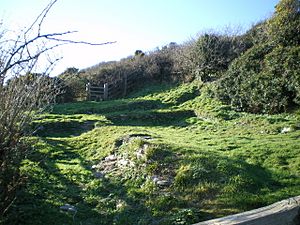Lammana Priory facts for kids
The Lammana Priory was a small religious building on Looe Island in Cornwall, UK. It was home to just two Benedictine monks until the year 1289. A priory is like a small monastery. This priory belonged to a much larger and more famous monastery called Glastonbury Abbey. In 1289, the land and buildings were sold to a local rich person.
Contents
History of Lammana Priory
The Priory of St Michael of Lammana was owned by Glastonbury Abbey during the Middle Ages. It had two main chapels. One chapel was on top of Looe Island itself. The other chapel was directly across from the island on the mainland.
Monks' Living Quarters
There was also a third building called the Monk's House. This was about 150 yards down the hill from the mainland chapel. It was where the monks lived. The priory also had a dining hall, called a refectory. This was for pilgrims, who were people who traveled to visit the island for a special religious day called Michaelmas.
Early Records of the Priory
The first official record of the priory is from 1144. This was a special approval from Pope Lucius II. This approval, called a Privilegium, was given when Bishop Henry of Blois was in charge of Glastonbury Abbey. He was the brother of King Stephen.
About 60 years later, around 1200, another important document appeared. It was a charter from Hasculf de Soleigny. He was the lord of the manor of Portlooe. This charter officially gave the Island of St Michael of Lammana to the Church of the Blessed Virgin Mary of Glastonbury. It included all its lands and special payments called tithes, which they had owned "from of old."
Land and Disputes
Even though it wasn't a parish, the priory controlled about 297 acres of land. This land stretched from St Nicholas Church in West Looe. It went up West Looe Hill to the Talland Road junction. Then it went south to the Portlooe manor and down to a field called Old Mills.
The ownership of these tithes caused a long argument. The Augustinian canons from Launceston Priory also claimed them. They had gained control of the Talland parish in the early 1200s.
Selling the Priory
Around 1240-1250, Earl Richard of Cornwall allowed Glastonbury Abbey to rent out the Lammana manor. Then, on June 24, 1289, the right to control the island chapel was sold. It was bought by Walter of Treverbyn, who was the lord of Portlooe.
The argument over ownership started again. Walter had to sue Launceston Priory for £40 in damages. In October 1290, the Sheriff of Cornwall was told to gather a jury. This jury of twelve local men made a decision at the Court of Common Pleas in Westminster. They decided in favor of Walter.
End of the Chapels
The chapels continued to be used until the Dissolution of the Monasteries. This happened in the mid-1500s during the time of Henry VIII. Eventually, the buildings fell apart. By the mid-1800s, they were mostly ruins, with only a few walls still standing.
Archaeology at Lammana
Archaeology is the study of human history and prehistory through digging up old sites. In 1935 and 1936, the mainland chapel was dug up. This work was done by Charles Kenneth Croft Andrew, an expert in old things and an archaeologist. He had help from Rev. Henry Ardern Lewis and Mr C.B. Willcocks.
Later Research
In 1994, Dr Lynette Olson and her team looked at Croft Andrew's findings again. They re-evaluated the information from the earlier digs.
In 2008, the TV show Time Team from Channel 4 did their own digs. They explored Looe Island and the mainland. Wessex Archaeology was hired to record what was found and study the sites.
What Archaeologists Found
Looe Island Discoveries
The archaeologists found no clear proof of prehistoric activity on either site. A large stone buried near Island House might have been prehistoric. But it had been moved from somewhere else on the island.
They found pottery from the Roman-British period (AD 43-410) in two ditches. They also found a small collection of eight Roman coins. These coins were made between AD 253 and 330. The newest coin was from the time of Constantine the Great (who died in 337).
The chapel on the island was built in one main phase. A buttress, which is a support structure, was added to the southwest corner of the nave in the 13th century. They found a human burial under the chancel arch area. A second burial was found outside the chapel's southern wall. The age of these burials could not be precisely determined. Pottery found near the chancel burial was from the 15th or 16th century.
Mainland Chapel Discoveries
Wessex Archaeology confirmed the 1930s map of the mainland chapel. It had a nave (the main part of the church) and a chancel (the area near the altar). There was a porch facing south and another entrance to the north.
They found signs of a rood screen. This was a screen that separated the nave from the chancel. Usually, only the priest or chaplain could go into the chancel. Lords of the manor, who often had special rights, could also enter.
One human burial was found in the southeast corner of the chancel. A stone-lined box, called a reliquary, was found in the middle of the chancel. Reliquaries held very special items. These could be holy relics or the bones of a saint who started the site.
A bone from the arm (a humerus) of the buried person was tested. This test, called radio carbon dating, showed the person lived between AD 1200 and 1280. The skeleton was of an adult male, aged 35-55, about 5 feet 4 inches tall. Wessex Archaeology concluded that the exact date the mainland chapel was built is still unknown.


